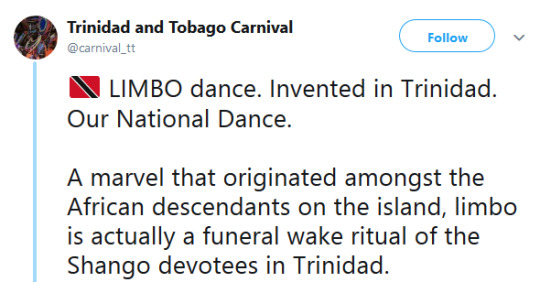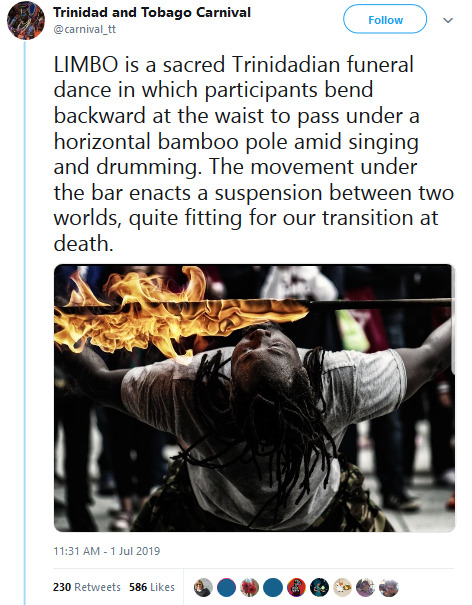Text
The panic over COVID-19 causing people to hoard shit unnecessarily means I can't find medical supplies (like disinfecting alcohol wipes) without paying an obnoxiously exorbitant amount.
Generally healthy, able-bodied people don't need masks, exam gloves, or alcohol swabs to protect themselves against COVID-19. But chronically ill people and their caretakers do need those supplies to live their everyday lives.
Calm the fuck down and wash your fucking hands, ableds.
86K notes
·
View notes
Photo
BS like this boils my blood. They better be thankful folks are not running around with a spear in 2020 cause a colonizer head on the tip would be #aestheticaf 👏🏽
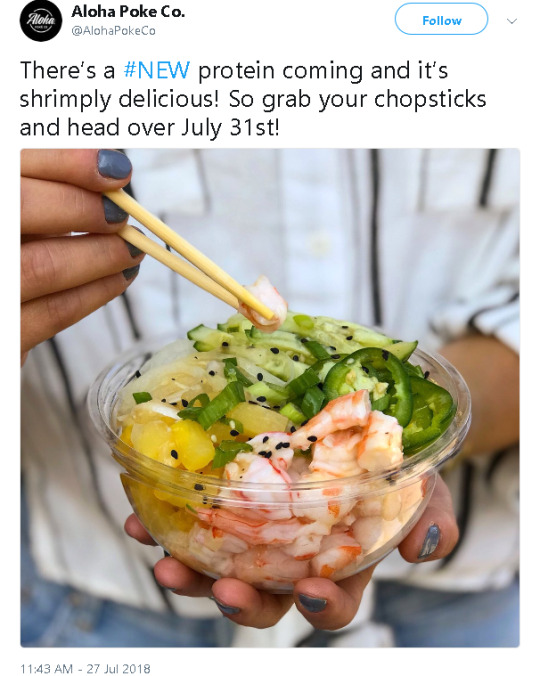


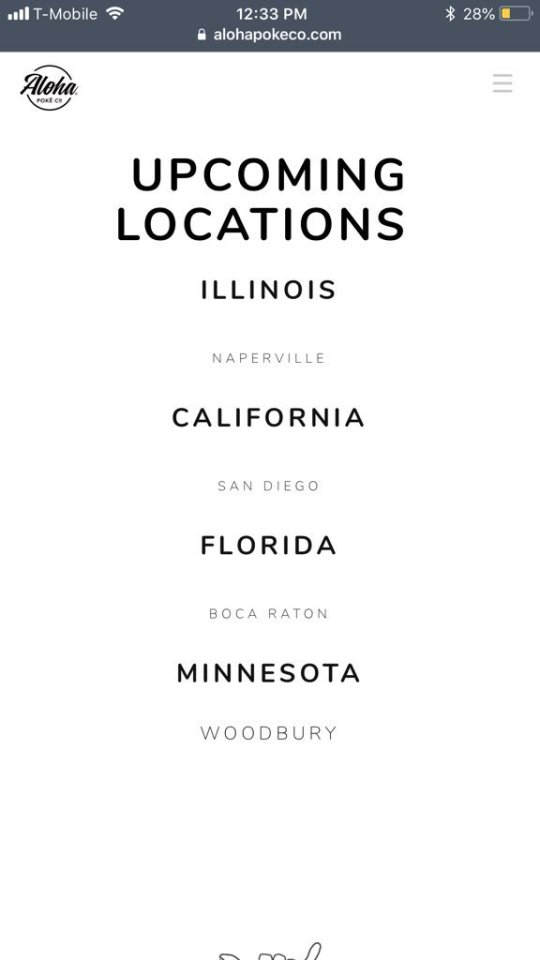
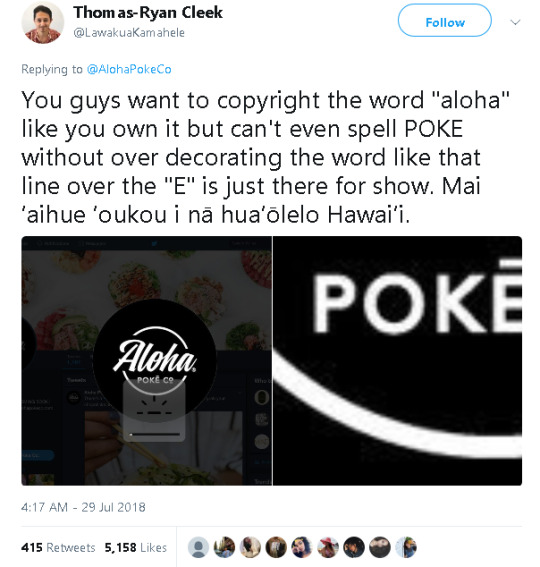
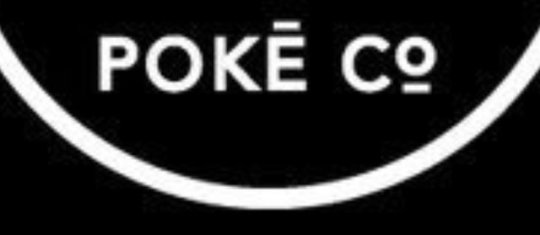
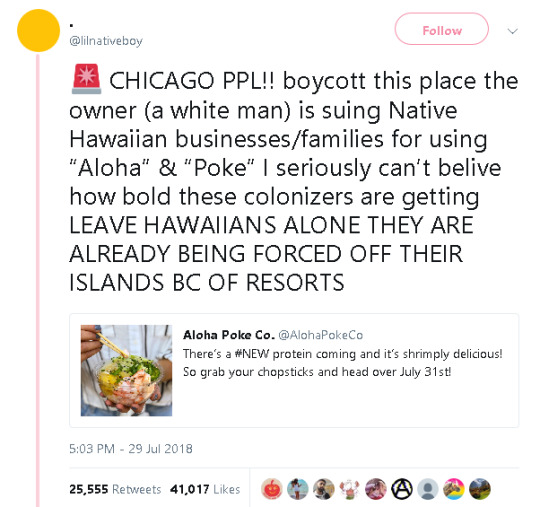
Yt people stay on their bs..Boycott this colonizer y’all!!
90K notes
·
View notes
Photo
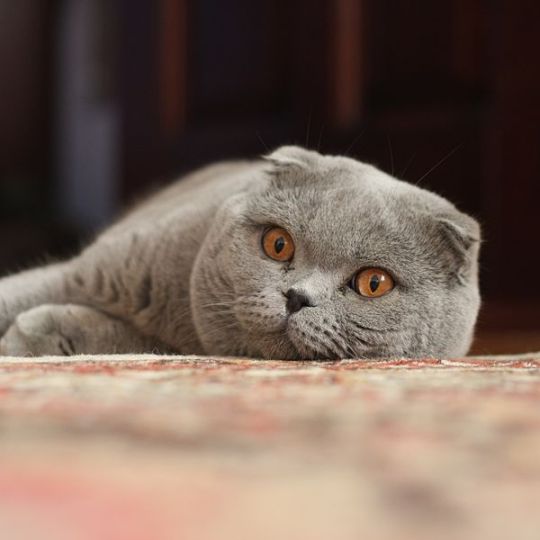
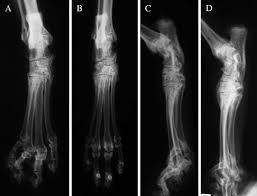
If you love Scottish fold cats, I’m going to tell you something you don’t want to hear. Please, please read on anyway. If you are considering adopting a Scottish fold, PLEASE continue reading. This information needs to be more widely known.
In 2008, the Journal of Small Animal practice released a short report on disorders associated with breeds of cats. In this report, the authors mentioned the Scottish fold:
People who own them may be “charmed” by their round faces and open expression (and they may not realise that the reason the cats do not move around too much is because they are variably crippled with arthritis).1
The gene that causes the cute fold in the Scottish fold’s ear also leads to the development of a degenerative disorder called osteochondrodysplasia. ALL Scottish folds have this disorder, whether they show symptoms or not- the fold in their ears is caused by a cartilage deformity that also affects their joints.
Osteochondrodysplasia leads to crippling osteoarthritis, which affects Scottish folds at much younger ages than other breeds of cats. In cats heterozygous for the gene, the disease’s progression can be seen in cats as young as six months. In homozygous cats, it can be seen as early as seven weeks old.
Affected cats may be grossly deformed, with short wide limbs and a short, inflexible tail. They show lameness, swollen wrist (carpal) and ankle (tarsal) joints, have an abnormal gait, and are reluctant to move and jump. Severely affected individuals become crippled and unable to walk.
…Many affected cats are euthanased earlier in life due to the profound effects of this disease.2
The breed is often described as “placid” and “calm.” This is due to the fact that they are constantly in pain due to this disorder. Even in mild, ‘asymptomatic’ cases which can occur in heterozygous cats, they may still be experiencing pain due to cats’ tendency to hide their suffering.
Many breeders of Scottish folds claim that not all heterozygous cats have the disorder, because the studies that examined the cats (which were all, heterozygous or not, shown to have it) had small sample sizes.
In 2003, Lorraine Shelton, a specialist in genetic diseases, offered to pay for 300 x-rays of healthy adult Scottish folds to prove that the disorder was not present in some heterozygous cats.
…She has asked a list of 300 Scottish Fold breeders from around the world to go to their vet to get X-rays done. She had offered to pay for these X-rays but not a single breeder had taken up that offer. You could not know whether this problem existed unless an X-ray was taken. If somebody would send her an X-ray of a healthy hind leg of a folded eared cat, she would be grateful as she wanted to see the very first one.3
To date, no one has taken her up on the offer. The breeders’ unwillingness to have their cats examined speaks volumes. The authors of all studies on these cats agree: it ethically wrong to continue breeding these cats.
It disturbs me that any breeder would knowingly continue to create animals that will be in pain throughout their lives. As a cat lover myself, I am begging you, please do not buy Scottish folds. Do not support these unethical breeding practices, or the concept that it is acceptable to intentionally breed unhealthy animals for the sake of how they look.
Citations
1 Breed-related disorders of cats (discusses issues with other breeds as well)
2 Genetic welfare problems of companion animals: osteochondrodysplasia (a thorough description of the disease and its prevalence)
3 FIFe meeting notes (leading to a decision not to recognize Scottish folds as an offical breed due to the disorder)
There was also a follow-up email about Shelton’s offer which can be read here.
Studies on osteochondrodysplasia in Scottish Folds
Osteochondrodysplasia in Scottish Fold cats
Incomplete dominant osteochondrodysplasia in heterozygous Scottish Fold cats (this is the source of the above x-ray pictures)
Before you buy ANY animal, please do your research. If a breed suffers from high incidences of genetic disorders, don’t use your money to support the creation of more animal suffering.
94K notes
·
View notes
Text
It goes back to the idea of the earth and its "resources" (land, people, animals, etc) being resources. Always ready to exploit in some way or another, be it for "evil" or for "good". The idea that nature is a thing to be used instead of honored is what drives both colonialism and new ageism.
really uncomfortable the way white people “value” indigenous knowledge not out of genuine respect for it or the fact that its rooted in thousands of years of experience, but because we’re in an age where everyone is concerned with “getting back to the earth” and see indigenous peoples as like… basal, uncomplicated, technologically lacking, and thus wholesome. im tired of hearing about “simple ancient primitive techniques” and shit. in the past i would have given writers the benefit of the doubt for such language, but it should be clear to everyone now, especially “socially conscious” current events bloggers, the connotations of those terms lol
12K notes
·
View notes
Photo

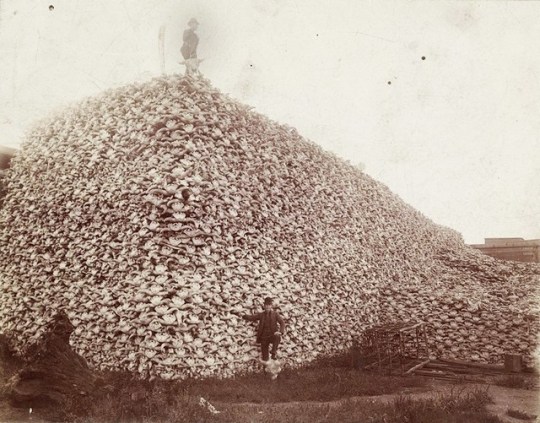
White Settlers pictured above with Bison Hides and Skulls
During the Plains Indian Wars, as the U.S. Army attempted to drive Indians off the Plains and into reservations, the Army had little success because the warriors could live off the land and elude them—wherever the buffalo flourished, the Indians flourished. But pressure on the Army to contain the Indians increased in the 1860s when gold was discovered in the Montana Territory, and part of what is now eastern Wyoming became the route of the Bozeman Trail, the quickest way to get to the mines in Montana…
The government realized that as long as this food source was there, as long as this key cultural element was there, it would have difficulty getting Indians onto reservations.
Colonel Dodge said in 1867, “Every buffalo dead is an Indian gone,” and Delano wrote in his 1872 annual report, “The rapid disappearance of game from the former hunting-grounds must operate largely in favor of our efforts to confine the Indians to smaller areas, and compel them to abandon their nomadic customs.”
While it wasn’t feasible for the U.S. Army to kill tens of millions of bison, it was feasible for the Army to let hunters use their forts as bases of operation and stand by as they slaughtered the animals in staggering numbers. Another key strategy here was that the Army made no effort to enforce all those treaty obligations forbidding whites to hunt on Indian lands. Whites could needlessly kill a bison for “sport” but when an Indian killed cattle for food for his family because of the growing scarcity of bison, he was severely reprimanded.
Read the full article on Indian Country Today
2K notes
·
View notes
Text
how can people look at a dog that literally looks like a toad and go like “hm yes this looks like a healthy and ideal specimen of an animal”
1K notes
·
View notes
Text
This was beautiful, and essential. I've read so much about indigenous eating and spirituality worldwide, and a common thread seems to connect them all that is absent in the extremely hegemonic Western Man>Animal narrative, is that animals are beings like humans, with spirits, and that animals may have become humans and vice versa in the past. Veganism is not an upperclass white thing. In fact, way before modern veganism, practicing Jains, Rastafarians, and even people during the Biblical era in the middle east/north Africa, "ate only the herb" and abstained from meat, which actually ended up being a huge issue in some of Paul's writings in the New Testament. In Ethiopia, there are holidays where animal products are not to be touched, resulting in a traditional vegan food menu in the Habesha culture.
There are some tribes who live mostly off of tubers. And with gathering being traditionally feminine throughout the world, reclaiming veganism is a way of restoring ancient matriarchal customs.
I’m going to talk to you today about barriers to creating an Aboriginal veganism. I’ll talk a bit about traditional food, and human-animal relationship in Mi'kmaq legends. And I’ll end with the concept of “M`sit No`maq,” which means “all my relations”.
There are two main barriers to an Aboriginal veganism. The first is that veganism is often equated with whiteness. As a result, Aboriginal vegans are assumed to be inauthentic and assimilated.This presents a challenge for people like me, who view our veganism as compatible with our Aboriginality. Ojibwa playwright Drew Hayden Taylor jokes, “What do you call a Native vegetarian?” His answer: “A very bad hunter.” The implication is that for Aboriginals,choosing a non-meat diet is a kind of cultural failure.
A second barrier to Aboriginal veganism is its portrayal as a product of class privilege. Opponents claim that a vegan diet is an indulgence. And the poor - among whom Aboriginal people are disproportionately represented - can’t afford to be so picky. This assumes that vegans eat highly processed food products, and it overlooks the economic and environmental cost of meat,and assumes that the subsidized meat and dairy industries in North America are representative of the entire world.
While it’s true that I favour an increase in Aboriginal veganism, I’m not proposing that we replace a vibrant food culture with one that’s, maybe, a little more alien. The truth is, the eating habits of Aboriginal people have already been colonized. People have been trained to think that poverty is Native. So we see Aboriginal restaurants that have balogna, wieners and canned meat wrapped in fry bread on their menu. What we’re doing is traditionalizing our own poverty. Lack of access to nutrient-rich foods is a problemthat Aboriginal people have in common with other oppressed groups. Konju Briggs Jr. notes that poor communities of colour in the U.S. lack access to healthy food and as a result are disproportionately affected by diabetes and heart disease.In Canada, the reserve system resulted in a diet high in sugar and carbohydrates and low in protein and fibre. As a result, Mi'kmaq people have seen a serious increase in diabetes and gallstones. Professor of Human Ecology, Kim Travers sees three reasons for this nutrient poor diet among the Mi'kmaq: First, most of us have very low incomes. Second, we lack of access to transportation so we can’t go to things like farmers markets. And third, our reserves are situated on land that isn’t suitable for agriculture, so we can’t grow our own food. Mi'kmaq people living on reserve are often limited to eating protein such as peanut butter, wieners and bologna. So, what’s the problem with developing an Aboriginal veganism? Well, it’s hard to frame it as a traditional activity. Historically, the Mi'kmaq diet was meat-heavy. We ate beaver, fish, eels, birds, porcupine, and sometimes whale,moose, or caribou. And we supplemented this meaty diet with vegetables, roots, nuts and berries.The use of animals as food figures prominently in our legends. So that’s an issue. Second, food production is gendered in Mi'kmaq culture. Hunting was a traditionally male activity connected with the maintenance of virility. The killing of a moose symbolized a boy’s entry into manhood. So when you challenge the hunting traditions, you’re challenging howMi'kmaq men understand their masculinity. At the same time, I want to suggest that the context in which Aboriginal gender identity develops has changed significantly since colonization. Meat, as a symbol of patriarchy, actually binds us closer to white colonial culture,than practices such as veganism do. Veganism might be seen as white, but it’s certainly not hegemonic.
So, desperate for some way to understand my veganism together with my Mi'kmaq culture,I started delving into our legends. In our stories, animals are our siblings. Mi'kmaq legends view humanity and animal life as being on a continuum. Animals speak, change into human form, and some humans marry these shapeshifters and raise children together. Human magicians may takeanimal form, and some people are transformed into animals against their will.An ecofeminist exegesis of Mi'kmaq legends enabled me to see my veganism as a spiritual practice that reflects the fact that humans and other animals possess a shared personhood. Quick show of hands, how many people have heard of Glooscap, and have any idea who he is? Okay, not very many people at all.So, Mi'kmaq legends portray human beings as intimately connected with the natural world.Glooscap is sort of our main figure in Mi'kmaq legends. He’s like an Adam. He’s sort of like a Hercules or a Superman.He’s this prototype human being, who has special powers.So, for instance, in our legends Glooscap is formed from the red clay of the soil of Prince Edward Island. In the story of “Nukumi and Fire”,the Creator makes a grandmother, Nukumi, for Glooscap from a dew-covered rock. She agrees to providewisdom in exchange for food. When Nukumi explains she cannot live on plants and berries alone,Glooscap calls to Marten, and asks him to give his life so Glooscap’s grandmother can live.Marten agrees because of his friendship with Glooscap. For this sacrifice, Glooscapmakes Marten his brother. Based on this story, it seems like Glooscap wasn’t a hunter priorto the arrival of the grandmother. This story also represents, through the characters ofGlooscap and Martin, the basic relation of the Mi'kmaq people with the animals around us.The animals are willing to provide food, clothing, shelter and tools,but they must be treated with the respect given a brother and friend.A Mi'kmaq creation story tells of the birth of Glooscap’s nephew from seafoam caught in sweetgrass.Glooscap calls upon the salmon to give up their lives so he can feed his newphew. Although not unproblematic,this dynamic is at least open to the possibility of refusal on the part of the animal. As well, the storyundermines the widespread view that we have an innate right to eat animals.Glooscap and his family don’t want to kill all the animals - indicating moderation in their fishing practices.The theme is one of dependence, not domination. Animals have independent lives, their own purposes,and their own relationship with the Creator. They’re not created for food, but willinglybecome food in these stories as a sacrifice for their friends. This is a far cry from the perspective ofthe white colonial hunter, in which animals are constructed as requiring population control,turning slaughter into a service performed, rather than one received. An interesting exception to this thread is the Wabanaki story of “Glooscap and His People”,which blames the animals themselves for man’s aggression toward them. In this tale, Malsum,an evil counterpart to Glooscap, turns the animals against Glooscap. Glooscap announces, sounding oddly like a god-figure here:“I made the animals to be man’s friends, but they have acted with selfishness and treachery.Hereafter, they shall be your servants and provide you with food and clothing.“In this story, the original vision of harmony is lost, and inequality takes its place as a punishment for listening to Malsum.In this way, the story is sort of similar to the Genesis story of the expulsion of Adam and Eve from the Garden of Eden.Glooscap shows the men how to make bows, arrows and spears,and he shows the women how to scrape hides and make clothing.He says: "Now you have power over even the largest wild animals. Yet I charge you to use this power gently. If you take more game than you need for food and clothing,or kill for the pleasure of killing, then you will be visited by a pitiless giant named Famine."Even in this story, which attempts to justify dominion, the proper relation tothe animals is only for food and clothing. If animal consent is required to justify theirconsumption, then it opens the possibility that such consent might be revoked.Another feature of Mi'kmaq stories is theregret that comes with animal death. In "The Legend of the Wild Goose”, Glooscap is concerned for the safety of the migrating birds and he charges the Canada Goose with their protection.“The Adventures of Katoogwasees” tells how Glooscap’s grandmother used magic to obtain an unlimited amount of beaver meat from a single bone, reflecting a wish for abundance disconnected from the need to hunt.Regret and kinship also feature in the story of “Muin, The Bear’s Child”. In one version of the tale, a young boy, Siko, is trapped in a cave by his evil stepfather and left to die. The animals hear him crying but only the bear is strong enough to remove the rocks from the front of the cave. Siko is adopted and raised as a bear. Later, Siko’s bear family is attacked by hunters and his mother is killed. He addresses the hunters in Mi'kmaq and pleads with them to spare his sister. The amazed hunters put down their weapons and spare the bear cub.In addition, they are sorry for having killed the bear that had been so good to Siko.At the end of the story, Siko takes on the name Muin, the Bear’s Son, and vows that when he grows up and becomes a hunter, he will never kill a mother bear, or bear children.The regret that you see in the Muin story is also expressed in rituals surrounding the act of hunting. One ritual, a dance,thanks the spirit of the animal for giving its life for food.
In contrast to the enlightenment view of humans as distinguished from animals by speech and thought, Mi'kmaq legends viewanimals as not only capable of thought and speech, but as people. The value of an animal lies not in its utility, but in its very essence as a living being.Happily for me, not all Mi'kmaq food traditions centre upon meat. Glooscap’s mother was a leaf on a tree given life and human form by the sun. The feast celebrating her birth consists of plants, roots, berries, nuts and fruit. If we recognize that activities traditionally performed by Mi'kmaq women, such as fruit, vegetable, and nut gathering, are also fully Aboriginal,then we can form indigenous counter-narratives to meat promotion. If women initiated hunting,as in the story of Glooscap’s grandmother, then surely changing circumstances empowerus to end it as well. The values obtained from an ecofeminist exegesis of Mi'kmaq stories can serve as a starting point for an indigenous veganism. The personhood of animals, their self-determination, and our regret at their death, all show that choosing not to ask for their sacrifice is a legitimately Aboriginal option. Since the consumption of animals for food, clothing and shelter is no longer necessary, as vegan culture demonstrates,then the Mi'kmaq tradition, as manifested in our legends, suggests that hunting and killing our animal brothers is no longer authorized.
Because Aboriginal people are the targets of genocide,the practices that we adopt are vitally important. Bonita Lawrence notes that daily life practices have been used to assess the authenticity of native identity claims, to accord Indian status, and to assess land claims. For instance, some Native land claims were rejected because the claimants had regular jobs and could be shown to have eaten pizza, instead of living off the land. Because Aboriginal people are judged based on how we eat and how we live, the choices that we make around this are extremely important. Because practices, such as veganism, may impact how white authorities assess our treaty rights. Yet those who value only preserving Aboriginal tradition join with colonialism in seeing no place for a contemporary indigeneity. There’s more to my culture and to my relationship with the land, particularly as a woman, than hunting and killing animals. One must also be aware of changing circumstances and needs among the Mi'kmaq. As research shows, Mi'kmaq people living on reserve are dependent on store bought food and, in addition, half of Canada’s Aboriginal population lives in urban areas. When Aboriginality is defined as a primordial lifestyle it reflects our intentional extinction as a people. The modern commercial fishery, often touted as offering economic security for Aboriginal communities, is even further removed from our Mi'kmaq values than modern day vegan practices are.
Commercial fishing frames fish as objects to be collected for exchange, while veganismis rooted in a relationship with animals based upon respect and responsibility.The ability to reinterpret our traditions, our rituals, enabled our ancestors to survivegenocide, famine, disease, forced moves, reserves, residential schooling, and a host of othercolonial ills. Urban Aboriginals, like myself, embody our traditional values in new rituals. Vegan meal preparation and consumption, for example, can become infused with transcendent significance,as we recall our connection with other animals, our shared connection to the Creator, and prefigure a time when we can live in harmony with other animals, as Glooscap did before the invention of hunting. Veganism offers us a sense of belonging to a moral community,whose principles and practices reflect the values of our ancestors, even if they might be at odds with their traditional practice. At stake in the creation of an Aboriginal veganism is the authority of Aboriginal people, especially women, to determine cultural authenticity. Dominant white discourse portrays our cultures as embedded in the past. But Aboriginal cultures are living traditions, responsive to changing circumstances. In retelling and reinterpreting our stories, or in creating new stories, Aboriginal women claim authority over our oral traditions. In doing so we recognize that our oral culture is not fixed in time and space, but is adaptable to our needs, to the needs of our animal siblings, and to the needs of the land itself.
To finish off, I’d like to say a few words about the phrase “M`sit No`maq”, which means “all my relations”. It basically encapsulates the Mi'kmaq perspective on the world. What does this phrase mean, exactly? Who are my relations? And I have a brief anecdote to share too, which I think encapsulates the concept: One day, after a big rainstorm, my dad came into the house, and said “Hey kids, I need your help. A frog laid a bunch of eggs in this puddle out back, and it’s drying up now, and they’re all going to die if we don’t get them into the pond.” So for the next two hours, in the sun and the muggy weather, we transported these gelatinous frog eggs and these squirmy little tadpoles from their shrinking puddle into the pond near our house. And as we did this, I realized that to my dad, the fragility of these animals mattered in the same way that our own fragility mattered. So for me, that was a really concrete experience of what that phrase “all my relations” means.“Let me not forget our mutual vulnerability”, and let the way that we treat each other reflect these ties that bind us all. Thank you. Welalin.
- Margaret Robinson is a vegan scholar and a member of the Lennox Island First Nation. Margaret grew up on the Eastern Shore of Nova Scotia, and holds a PhD in Theology from St. Michael’s College. Her work examines issues of food justice, Indigenous health, two-spirit identity, and cultural continuity. She is a Researcher In Residence in Indigenous Health at the Ontario HIV Treatment Network, and an Affiliate Scientist with the Centre for Addiction & Mental Health in Toronto, Ontario.
29 notes
·
View notes
Text
The earth, the animals too. We have to fix this collectively
I want y'all to know that colonialism has absolutely destroyed important knowledge and scientific research and also a diversity in scientific approach. Like I need y'all to remember that many cultures had many innovative systems prior to being colonized, be it medicine, politics, environmental science, agriculture all of it.
34K notes
·
View notes
Text
#animal identity vegan#animal welfare#speciesism#veganism#vegan for the animals#vegan for the environment#moral relativism#vegan#vegan for the ocean#denisovans#denisova cave
3 notes
·
View notes
Text
Earthday: a day for some people to pretend to care about the planet & animals
Nobody is perfect, including me. I am a lucky 3rd worlder who was fortunate enough to be raised in the richest 1st world country in the world. My background and my life experience have given me a unique, 2-headed view of life, the world, speciesism and capitalism.
I can see through the eyes of many, being trapped in the origin stock rainforest flesh of my ancestors while wearing the shoes and clothes of the colonial structure. I am one of few who have chosen the vegan path, the eco friendly path, the animal welfare path. Still growing and learning, tending to my indoors garden, trying to be modern and natural simultaneously.
Every April, Earth Day, yet another yearly moneymaker, rolls around. Holidays in the US are often not really sacred days but actually political and economic days. Companies jump out of the woodwork with "earth day" themed products, and suddenly everyone becomes an environmentalist for 24 hours before going back to the wasteful plastics, harmful chemicals, pollution, wasted electricity, excessive meat consumption, and casual participation in the home-to-landfill pipeline.
It makes me sad to see how easily people are goaded and tricked by the system. They would rather feel the instant gratification of a momentary change rather than commit every day to a cause that they pretend, on one day out of the year, to care about.
I am not perfect. Nobody is. But when the effort is possible, but not put in, it is a shame.
#animal identity vegan#animal welfare#speciesism#veganism#vegan for the animals#vegan for the environment#earth day#earth month#earth year#every day is earth day#environmentalism#vegan for the planet#vegan for the ocean
9 notes
·
View notes
Text
Enter, the most expensive mango on the market, and the most delicious! It has to be eaten at the exact right time for the best taste and juiciness.
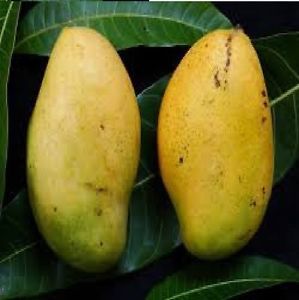
This article above fails to give us readers a glimpse of the faces behind this so-called monopoly ANEM which controls all exports of this exotic, novelty mango.
And why is there an effort to decrease the price of this little island treasure? Let's examine the fruit, and then the history of economic and food relations between Haiti and the Colonial Megastructure next door.

The first time I had one was as s gift from a local teacher who was a family friend. I had no idea what kind of mango it was, but after taking my first bite, my world changed.
How did I, child of the ancestors, not know about this Garden of Eden gem? It has a vibrant sweetness, high juice content and soft fibrous texture. Once ripe, this mango must be eaten immediately because they start to ferment fast and take on a "gassy" flavor, possibly due to a chemical like the ones in bananas or kiwis. The aroma is mesmerizing, and the shape of the fruit is like a very wide and curvaceous S.
Mangos have existed in the Americas for 250 years, originally from India. Mango experts say the Haitian francique variety has existed since the first breeds came over.
Haiti, supposedly "poor", is home to 66 varieties of mango alone. Drained by France's forced "reparations" post-independence, the food security of the heavily isolated & embargoed nation has been a matter of great concern in modern times, thanks to the exploitative actions of neo colonialism, Monsanto and corrupt foreign NGOs.
As a vegan, my consumption of this mango means more than just the perfect summer meal. I want my money to feed my people, feed their economy, feed their repertoire as the pearl of the Antilles.
But food is very complicated.
This legendary and mystery-enshrouded nation shares its island with the Dominican Republic, but has played a way more interesting role in the course of New World history since the 1700s as the first republic established by freed enslaved people. Its army helped Venezuela win its independence from Spain, and it cast the deciding vote for Israel becoming a state.
It's indigenous pig, the environmentally appropriate Creole Pig was made extinct via the efforts by American (hyper capitalist, speciesist) and governmental measures to eradicate it for the American fear of the African swine fever that struck the Dominican Republic spreading to the United States (basically, the pig that played a VITAL role in a common Haitian's life was made extinct to save America's already loaded pork industry). This extinction led to a domino effect of food security issues that reverberate to this day. The replacement of the Creole pig with unfit American breeds saw a drop in overall life quality amongst Haitians.
Scientists have created a breed of pig similar to the Creole Pig, with restoration efforts in place now. A bit late though.
This pig was interwoven in the folklore, barter economy, religion, and marriage rites of a nation that gives the world the a clearest example of how colonialism, speciesism and capitalism create hunger.
Vegans should approach "vegvangelizing" other cultures very carefully. For an intro to vegan Haitian cuisine, follow @DooseNYC on Instagram. Lots of already vegan options exist generally.
Banann peze
Mayi moulen
Coconut milk rice and beans
MANGO 😋
#animal identity vegan#animal welfare#speciesism#veganism#vegan for the animals#vegan for the environment#moral relativism#vegan#Haiti#Haitian mango#exotic fruit#mangoes#food security#third world food security#latin america#caribbean#creole pig#animal history#indigenous animals#animals as currency
4 notes
·
View notes
Text
Red Banana Mystery

Red bananas are a sweet and versatile kind of banana that originates from the West Indies and Central America. Unlike their popular Cavendish cousins, red bananas are antioxidant rich, containing carotenoids that give them their red color (and boost eye health!).
This Spring 2019, I'm noticing them in more mainstream markets in both Florida and New York. You can find red bananas in Walmart and Foodtown.
I wonder why they are suddenly gaining traction in the US? So far, one pound of them costs about $1.49, which is expensive. Let's see how this goes.
1 note
·
View note
Text
Non-human animals deserve better. But where do we start? Our diets? Our economic choices? Our attitudes? I wake up each morning and am sobered into a hard reality when I think about the fact that large populations on this planet see me, a homo sapien, as non-human. I cannot sit idly by and let the power structure that supports that belief let millions of sentient beings both simian and non-simian pay the price with their lives. Instead I have chosen to identify with my fellow creatures of God's grand creation, and fight the power with my diet, my low-waste purchases, my lifestyle, my attitude, my body and my creative works.
We cannot see the ocean weep because she is made of water.
I am vegan for all. For everywhere. For life.
#animal identity vegan#animal welfare#speciesism#veganism#vegan for the animals#vegan for the environment#vegan for the ocean#end single use plastic#low waste#zero waste#vegan primitivist#primitivist#decolonial#decolonize your mind#decolonize your diet#vegan decolonialism
9 notes
·
View notes
Text
The Persistent Animalization of Melanid/Origin Populations Globally & Why I'm Vegan for ALL Earthlings
I challenge all majority-melanid nations regardless of origin (African or Melanesian) to create patriation zones for these people in their countries the same way Haile Selassie I of Ethiopia created Shashamane for Jamaican Rastas who were being persecuted and killed in Jamaica for their beliefs.
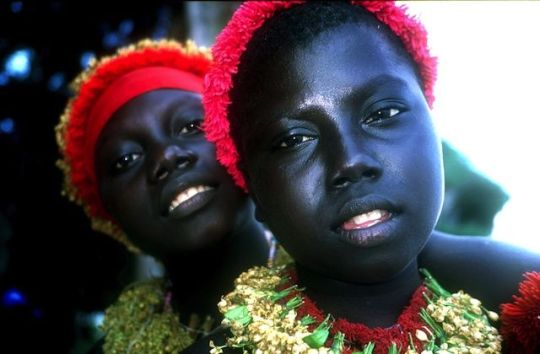
I challenge vegans of color to recognize, address and share the info regarding the blatant animalization by derivative-humans of isolated melanid groups who do not have the international visibility and cultural influence that Afro-Americans and Greater Africans have on the global stage.

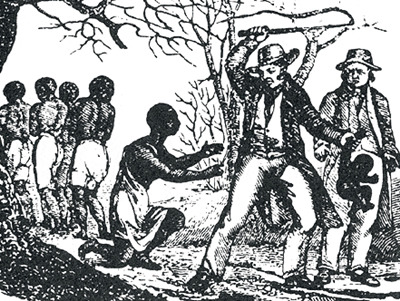
I challenge vegans and non-vegans of African descent especially, to OBEY the great Bob Marley and unite so that we can put our outrageous population numbers to good use by being the refuge and support system of melanid humans worldwide, which includes our similarly suffering cousins the Australian indigenous people, the Jarawa and the West Papuans. The slavery in Libya is just a repeat of medieval Morocco!


This story repeats itself over and over again. For 1000 years, this animalization of origin groups (melanid/Afroitic peoples) by derivative populations has been going on and on, and all it takes is disunity and complacency to allow it.
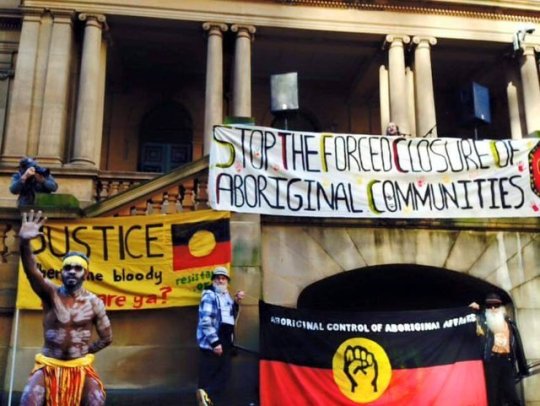
I challenge bloggers like Kwekudee and others to step up. I challenge Chronixx, Jay Z, Femi and Seun Kuti. I challenge Lupita Nyong'o, Viola Davis, Julius Malema and Donisha Prendergast.
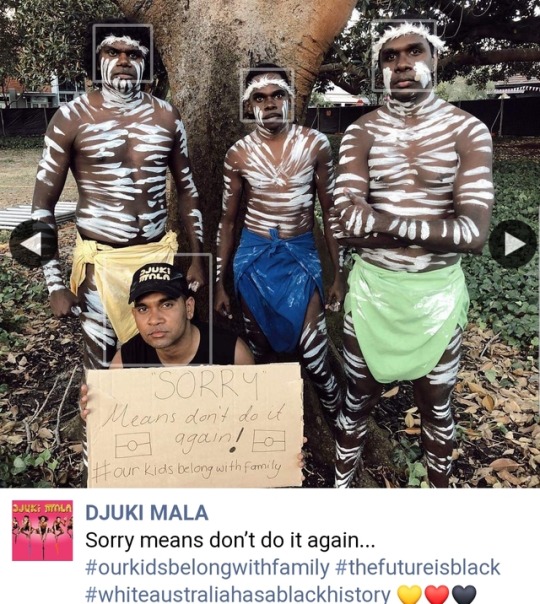
Derivative populations do not see any of us as human.
They. Do. Not. See. Any. Of. Us. As. Human.
This is our common denominator besides our overlapping skins, hairs, features, attributes. There is a clear reason why only groups that LOOK a certain way are treated a certain way. The capitalist-colonial power structure (both Western and Eastern) does not register our clusters of attributes as human attributes.


Ignore genetic distance. People don't see genes, they see skin. They see noses. They see hair. They see limb length. Cut the BS. Unite or perish! We do not have any military bases or organizations with the power to protect and defend our peoples, lands, oceans and animals.
We rely on others. We need to rely on and do for one another. Handouts will not fix things.
Nigeria, I challenge you. I challenge you to step up. As the most powerful economy in Africa with one of the most densely populated places in the world, please please please step up! The distant cousins of Africans are suffering on levels similar to and sometimes beyond Africans. The colonial massacres, the quashed rebellions, they happened. They stained flags. We all share this legacy.

And we will not tolerate terms like "negrito" (mini negro in Spanish)here or other colonizer terms (speciesism). Miss me with it. Serious discussion only.
#animal identity vegan#animal welfare#speciesism#veganism#racism#negrophobia#afrophobia#melanophobia#papua merdeka#free west papua#andaman islands#jarawa#we are humanity#organic jarawa#sentinelese people#onge people#save the jarawa#africa unite#marcus garvey#bob marley#frantz fanon#vegan for the environment#vegan for the animals#vegan for the ocean#vegan for indigenous people#vegan for aboriginal people#negrito#negritude#peuples noirs
2 notes
·
View notes
Text
Wait, huh???? I think there was a misunderstanding resulting from not wanting to let go of the silly argument, which was not aimed at regular folk but folk who choose not to understand ethical veganism.
Factory farm animals are tortured for days, that's why labels like "free range" and "grass fed" exist. Have you not seen those chickens forced into baby sized pens, too fat to fly? Too sick to move? If you read my blog you'd see that I am not an anti-carnist or an ARA, but an animal identity vegan, which posits oppressed or animalized human & non-human animals alike as the central crux of my veganism. Indigenous people hunting naturally is something I actually support in the transition to a non-corporatized global environmental reform.
Also, I addressed your final paragraph in bullet #3. Most crops are not grown for humans but for livestock, so the majority of the worst harvesting is for livestock. Humans who eat from their gardens or hand picked local farms divert themselves from the hyper capitalist source. Cruelty-free denotes exactly what it denotes. Cruelty is when you intentionally cause harm. Accidental deaths of minuscule creatures being crushed by giant machines is not cruelty. It is bad but it is not the same as intentional neglect or torture.
Veganism does not proport to be some kind of magical diet that removes one from all harm. It is a LIFESTYLE or philosophy that tries as practically possible, to deal less harm and suffering to animals. Accidental animal deaths are not cruel but accidental, and mostly mechanized harvesting of ground vegetables results in rodent deaths. People following the ideal, i.e harvesting their own food by hand and by stick, especially fruitarians, cause the least harm of all period. And if you're a third world vegan, even luckier. Our ancestors have been hand picking and scaling trees to get the eats for millennia. And with more children you can get more picking done. No gas-guzzling machines needed (but I won't discuss this generalization here. It is very complicated).
Torture, killing and casualty deaths are completely different. Killing is not torture. Death is not killing. Choosing to go out and torture then kill any organism is crazy. Not even indigenous hunters do that. Most people seek the fastest and easiest way to kill an animal, sparing it of suffering. Not saying accidental death is OK, just that the corporatocracy leaves few alternatives.
My post was not against carnists but bored & uncreative trolls who antagonize vegans as though all vegans are ARA. The militant ARAs are a vocal subset that do not represent all people who partake of this philosophy and lifestyle.
I think you have simply misunderstood me, friend. There is no argument between us. I was not coming for anyone but usual trolls who equate accidental rat deaths by machine to subjecting an animal to abject misery in a sprawling, cramped FEMA camp for animals. These will never be equal, and militant ARAs will never be the face of veganism, it is too diverse.
Please look into Temple Grandin. Not all Animal Welfare Activists are vegans and not all vegans are dogmatic ARAs. ARA= Animal Rights Activist. And even ARAs were not always seen as militant "meat is mirder" loons, as some activists are not.
Be blessed, and be well!
The flawed “Accidental Animal Deaths” argument against vegans 😂 Not on my watch
Disclaimer: I am not a dogmatic preaching vegan. I am a vegan who lives by example to inspire non-vegans to choose veganism. However, I am not #$%&ing stupid, regardless of the Elite seeing me as a low-IQ baboon.
We have all come across stubborn opportunistic faux-animal lovers who will say, “hundreds of animals are killed to harvest the vegetables that vegans eat” as if the vegetables are
1. Grown FOR vegans only 😂
2. Somehow more harmfully obtained than torturing LIVE animals for days at a time in abject misery before slaughtering them FOR carnists
3. Slaughtered animals themselves (vegetables/fruit are not sentient. They are alive. Big difference. And they need us to eat them to spread their seeds and pollen) Fun fact, some vegetables require picking to grow larger, example, herbs like chives and lettuces.
Then there’s this:
1. Don’t sit here and lie to me, pretending you care about the lives of field mice, rats and other rodents. Stay consistent. You can’t adopt your opponent’s argument against animal cruelty (which is not equivalent to accidental killing by the way) because they are completely different things.
2. You do not care about rat deaths in corporate machine-based harvesting. Almost all crops grown are to feed livestock, not humans. WAY less land would be needed for that. On top of that, some farms like small local farms are hand picked. Some people eat from their home gardens (the ancient, tried and true IDEAL) and do not accidentally kill rats. Faux-anti-speciesism is the worst because you’ll be quick to torture and kill a rat for the hell of it if given the chance but you cry for them when a vegan eats broccoli? Do you not see how comical that is? It’s literally hilarious.
To conclude this final rebuttal to the phony But Broccoli Cries When You Pick It crew, I just want to say, I used to be ignorant asf before I went vegan too. I used to call veganism a cult and talk about how stupid it is. But ignorance is bliss. Getting woke brings a rude awakening.
16 notes
·
View notes
Text
Totems: another way by which animal welfare/ethics/protections existed before the advent of modern veganism
In many ancient cultures worldwide, the tradition of assigning animal totems made extinction and overkill virtually impossible in indigenous societies.
Totems were basically animal species attached to a person from birth that connected them with the essence of that creature, and made it that they were not allowed to kill or consume that creature. This meant that there was a balance of various animal protection laws in place for these societies that ensured that over-hunting a specific species would not occur.
We know veganism will never be the diet of 100% of the Earth. By bringing back totems (a.k.a not forcing folks to erase their animal/interconnected/dual identities) and abolishing Colonialist trophy hunting and poaching (those 2 things did not exist until colonialism) we can achieve the goals of veganism and environmentalism without forcing it on communities. This will actually encourage change in the direction of veganism.
I wrote this to assert the reality that human societies must be viewed through eyes that have seen glimpses of the past, so as not to apply ill-fitting moral judgments. The belief that poaching is indigenous is a big lie that the Globalist Corporatocracy does not want to address.
Forced conversion to Superiority Paradigms has caused a massive imbalance and we must all work together, high and low, here and there, to reverse it. Instead of "death to all poachers" and crying over Cecil the lion or Harambe the gorilla, we MUST address how animal rights only seem to appeal to the common western non-vegan (and vegan alike) when a fellow victim of Speciesism commits the crime.
It is more complicated than who. It's about when and why too. We must also examine the Elite East's role in this mess as well. The working class worldwide is being animalized each day. So we must come together to examine Animal Identity and how such a concept can help unify people of varying backgrounds.
#totems#totem#indigenous history#poaching#extinction#animal extinction#environmentalism#veganism#maafa#colonial consequences#colonialism#africa#australia#turtle island#aboriginal history#cecil the lion#harambe#poachers#animal welfare#speciesism#moral relativism#animal identity vegan#animal identity
0 notes
